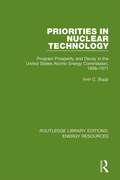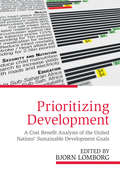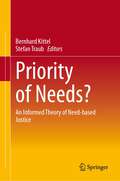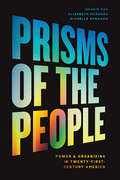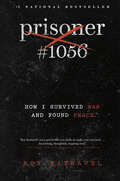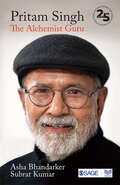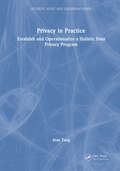- Table View
- List View
Prinzipien und Konzepte zur Weiterentwicklung einer Aufbereitungseinheit für Medizinprodukte zu einer Hochverlässlichkeitsorganisation (BestMasters)
by Philipp HahnWiederaufbereitung gebrauchter Medizinprodukte (MP) dient dazu, MP nach operativen Eingriffen zu reinigen, zu desinfizieren, zu überprüfen, zu packen und zu sterilisieren. Sachgerechte und rechtskonforme Wiederaufbereitung von MPs in einer Aufbereitungseinheit für MP (AEMP) zwecks Verwendung am Patienten ist eine komplexe Dienstleistung mit höchsten Anforderungen an Verlässlichkeit in den Qualitätszielen Sauberkeit, Sterilität, Funktionsfähigkeit, Vollständigkeit und Pünktlichkeit der ausgelieferten Produkte. Das neue vorgelegte Konzept geht davon aus, dass eine AEMP wegen ihrer Bedeutung für die Abläufe eines Klinikums und wegen der Komplexität der Anforderungen als Hochverlässlichkeitsorganisation (HRO) zu betrachten ist. HROs gelingt es, komplexe und technologieintensive Verfahren mit sehr geringer Fehlerrate und nahezu Ausbleiben von katastrophalem Versagen einzusetzen. Die anhand von HROs gewonnenen Erkenntnisse nutzt der Autor für sein Konzept, um Herausforderungen beim Betrieb einer AEMP mit solchen Verfahren anzugehen, die bei HROs erprobt sind und dort erfolgreich gehandhabt werden. Daraus wird ein Konzept zur Weiterentwicklung einer AEMP in Richtung einer HRO entwickelt und vorgestellt.
Prioridades na negociação de adesão da Roménia à UE: Integração europeia
by Perju GenovevaA competitividade das exportações romenas melhorou tanto como resultado da reestruturação da economia como da desvalorização da moeda. O exemplo da produção industrial é ilustrativo. A produção da indústria de processamento diminuiu com 8% em 1999 face a 1998, a sua participação em exportações aumentando de 30,7% a 35,1%, e a taxa de crescimento das exportações foi de 5,9%. O efeito principal foi uma redução do défice da conta corrente. Em geral, o défice da conta corrente flutuou, representando, em média, 5,2% de PIB. O défice orçamentário foi difícil de controlar, mas conseguiu-se através da aplicação dos rigores da União Européia. Podemos falar sobre desempenhos também em termos do nível da dívida externa em relação ao nível da dívida externa da União, que se situa em um nível mais elevado em comparação com o de outros países candidatos. O mercado de trabalho foi afetado por desequilíbrios, tanto no nível da relação entre a população ativa e a inativa, quanto na taxa de emprego. A população ocupada na agricultura detêm aproximadamente 40% do total da população ocupada. Além disso, uma grande parte da população foi afectada pela pobreza (aproximadamente 33,8%), em especial a população do meio rural (40,5%). Num tal quadro interno e internacional, marcado por interdependências com ecos em plano interno da União ou dos países candidatos, a resolução de situações divergentes ou a eliminação dos obstáculos no caminho de assumir certas obrigações e execícios da vontade política, a qualidade e a experiência do negociador podem ser consideradas decisivas para a continuação da cooperação.
Prioridades: Cómo ordenar nuestra vida para obtener mejores resultados
by Mario J. GuzmánPrincipios que transforman su relación con Dios, vida familiar y ministerio Existen grandes soñadores que no han podido ver sus sueños realizados por el desequilibrio y la indiscipllina que hubo en sus vidas. Otros han logrado sus sueños, pero en el camino LA FAMILIA se ha debilitado y desintegrado. Muchos hijos de personas exitosas no han tenido un desarrollo saludable. Podemos alcanzar éxito, pero: ¿Quién se está llevando lo mejor de nosotros? Procuremos que nuestra familia o nuestra intimidad con Dios no sea el precio de nuestro éxito. Conozca la importancia de ordenar su vida y de establecer prioridades. El pastor Mario J. Guzmán presenta de una forma clara y práctica principios bíblicos que le ayudarán a: -Tener una relación madura con Dios - Tener un noviazgo bien enfocado - Tener un matrimonio e hijos saludables - Desarrollarse en el ministerio eficazmente - Elevar su área laboral a la excelencia - Ser de voluntad firme - Terminar las cosas que ha comenzado
Prioritarianism in Practice
by Matthew D. Adler Ole F. NorheimPrioritarianism is an ethical theory that gives extra weight to the well-being of the worse off. In contrast, dominant policy-evaluation methodologies, such as benefit-cost analysis, cost-effectiveness analysis, and utilitarianism, ignore or downplay issues of fair distribution. Based on a research group founded by the editors, this important book is the first to show how prioritarianism can be used to assess governmental policies and evaluate societal conditions. This book uses prioritarianism as a methodology to evaluate governmental policy across a variety of policy domains: taxation, health policy, risk regulation, education, climate policy, and the COVID-19 pandemic. It is also the first to demonstrate how prioritarianism improves on GDP as an indicator of a society's progress over time. Edited by two senior figures in the field with contributions from some of the world's leading economists, this volume bridges the gap from the theory of prioritarianism to its practical application.
Priorities in Nuclear Technology: Program Prosperity and Decay in the United States Atomic Energy Commission, 1956-1971 (Routledge Library Editions: Energy Resources)
by Irvin C. BuppOriginally published in 1988. This book considers why some public policies succeed and others do not. It looks at the entrepreneurial process that creates public policies and examines whether they prosper or falter because of their political consequences. The programs and personnel of the Atomic Energy Commission are the empirical foundation for these arguments. The data generated by that agency's annual budget-making cycles, collected over time and organised by program, are used as evidence to test some propositions about policy formation within the executive branch of government. The author's concern is with questions of where and how priorities are established in a complex institutional environment. To answer the more fundamental causal question of why some programs prosper while others wither or die, use is made of more historical analysis and comparison of the fortunes of several of AEC's efforts to develop applied nuclear technology.
Priorities in negotiating Romania's accession to the European Union: European integration
by Perju GenovevaPriorities in negotiating Romania's accession to the European Union by Prof. ec. Dr. Genoveva-Elena period Priorities in negotiating Romania's accession to the European Union The competitiveness of the Romanian exports has improved both as a result of the restructuring of the economy and the devaluation of the currency. The example of industrial production is illustrative. Production of the processing industry decreased by 8% in 1999 compared to 1998, its share in exports increasing from 30.7% to 35.1% and the export growth rate was 5.9%. The main effect was a reduction of the current account deficit. Overall, the current account deficit fluctuated, representing on average 5.2% of GDP. The budget deficit was difficult to control but it was achieved by applying the European Union's strictures. We can also talk about performance in terms of the level of external debt relative to the level of the external debt of the Union, which is at a higher level than other candidate countries. The labor market was affected by imbalances both in the ratio of the active and inactive population and in the employment rate. The population employed in agriculture owns about 40% of the total employed population. In addition, a large part of the population was affected by the poor (approximately 33.8%) population, especially in rural areas (40.5%). In such an internal and international framework marked by interdependencies with echoes internally from the Union or candidate countries, resolving divergent situations or removing obstacles to assuming obligations and arousing political will, the quality and experience of the negotiator can be considered decisive for further cooperation.
Prioritising Wellbeing and Self-Care in Higher Education: How We Can Do Things Differently to Disrupt Silence (Wellbeing and Self-care in Higher Education)
by Narelle LemonThis book illuminates international voices of those who feel empowered to do things differently in higher education, providing inspiration to those who are seeking guidance, reassurance, or a beacon of hope.Doing things differently comes with an awareness and curiosity to explore what can be. Increasingly, more and more professionals in higher education are choosing themselves, happiness, families, relationships, kindness, and compassion over arbitrary notions of institutional prestige, continuous pressure to overwork, and competitiveness with others. The chapters in this book do more than highlight flaws in the system, they call for proactive engagement in interrupting and reimagining what is broken. The authors share their own experiences as a way of encouraging readers to take small steps towards self-care, to notice their surroundings, and to embrace change as an empowering tool. The focus is on becoming the change we aspire to see, with a collective readiness to instigate positive transformations.Sharing ambitious ideas to encourage change, this book is a valuable resource for those seeking to enhance their self-care and wellbeing in the higher education context, and for those seeking to engage with others in support of these efforts.
Prioritize Brands in the Portfolio: Developing a Brand Portfolio Strategy in a Silo Environment
by David AakerMost CMOs looking at their organizations see too many brands with too few priorities and too little leverage-a context that makes it difficult to create strong brands and effective marketing. Silos, particularly product silos, can significantly contribute to brand proliferation and the absence of an effective portfolio strategy. Developing a brand portfolio strategy in a silo environment involves making the decision to add or eliminate brands, assign roles and establish priorities, and determine how to leverage the strategic brands. This chapter introduces three frameworks that can help.
Prioritizing Development: A Cost Benefit Analysis of the United Nations' Sustainable Development Goals
by Bjorn LomborgThis book is a unique guide to making the world a better place. Experts apply a critical eye to the United Nations' Sustainable Development agenda, also known as the Global Goals, which will affect the flow of $2.5 trillion of development aid up until 2030. Renowned economists, led by Bjorn Lomborg, determine what pursuing different targets will cost and achieve in social, environmental and economic benefits. There are 169 targets, covering every area of international development – from health to education, sanitation to conflict. Together, these analyses make the case for prioritizing the most effective development investments. A panel of Nobel Laureate economists identify a set of 19 phenomenal development targets, and argue that this would achieve as much as quadrupling the global aid budget.
Prioritizing Faith: International Religious Freedom and U.S. Foreign Policy
by Ashlyn W. HandUncovers the political, ideological, and bureaucratic forces that shaped the International Religious Freedom Act of 1998 and its legacy across the Clinton, Bush, and Obama administrationsThe International Religious Freedom Act of 1998 formally established the promotion of religious freedom as a U.S. foreign policy and national security priority. Tracing its origins and passage, Prioritizing Faith shows how the legislation was made possible by the convergence of growing evangelical and Jewish advocacy, the expanding international human rights movement, and a broader search for post–Cold War purpose. Yet implementation across administrations has been uneven, shaped by shifting geopolitical dynamics and internal institutional constraints.Relying on expert interviews and rich archival analysis, Ashlyn W. Hand traces how Clinton, Bush, and Obama each wove international religious freedom into their foreign policy visions while navigating competing priorities and evolving strategic interests. Through case studies in China, Vietnam, and Saudi Arabia, Hand reveals the inner workings and persistent challenges of American religious freedom policy on the global stage.Timely, insightful, and deeply researched, Prioritizing Faith offers an incisive assessment of the United States’ efforts to promote religious freedom abroad, highlighting the enduring tensions between normative aspirations and the complexities of foreign policy practice.
Prioritizing Sustainability Education: A Comprehensive Approach
by Stephen Scoffham Joan Armon Chara ArmonPrioritizing Sustainability Education presents theory-to-practice essays and case studies by educators from six countries who elucidate dynamic approaches to sustainability education. Too often, students graduate with exploitative, consumer-driven orientations toward ecosystems and are unprepared to confront the urgent challenges presented by environmental degradation. Educators are prioritizing sustainability-oriented courses and programs that cultivate students’ knowledge, skills, and values and contextualize them within relational connections to local and global ecosystems. Little has yet been written, however, about the comprehensive sustainability education that educators are currently designing and implementing, often across or at the edges of disciplinary boundaries. The approaches described in this book expand beyond conventional emphases on developing students’ attitudes, knowledge, and behaviors by thinking and talking about ecosystems to additionally engaging students with ecosystems in sensory, affective, psychological, and cognitive dimensions, as well as imaginative, spiritual, or existential dimensions that guide environmental care and regeneration. This book supports educators and graduate and upper-level undergraduate students in the humanities, social sciences, environmental studies, environmental sciences, and professional programs in considering how to reorient their fields toward relational sustainability perspectives and practices.
Priority of Needs?: An Informed Theory of Need-based Justice
by Bernhard Kittel Stefan TraubThis book develops an empirically informed normative theory of need-based justice, summarizing core findings of the DFG research group FOR2104 “Need-based Justice and Distributive Procedures”. In eleven chapters scholars from the fields of economics, political science, philosophy, psychology, and sociology cover the identification and rationale of needs, the recognition and legitimacy of needs, the dynamics and stability of procedures of distributions according to needs, and the consequences and sustainability of need-based distributions. These four areas are studied from the perspective of two mechanisms of need objectification, the social objectification by the discursive generation of mutual understanding (transparency) and the factual objectification by the transfer of decisions to uninvolved experts (expertise). The volume addresses academics in the fields of justice research, ethics, political theory, social choice and welfare, framing, individual and group decision making, inequality and redistribution, as well as advanced students in the contributing disciplines.
Prioritäten richtig setzen: Wie Sie Ihre Zeit erfolgreich gestalten (essentials)
by Zach DavisWenn Sie (zu) viel zu tun und zu wenig Zeit haben, Ihr Alltag von Unterbrechungen, Unvorhersehbarem und hohen Anforderungen gekennzeichnet ist, werden Sie hier fündig. Sie erfahren, wie Sie die Fremdsteuerung in den Griff bekommen und durch ein verbessertes Selbst- und Zeitmanagement Ihre Produktivität steigern und den Stresspegel senken.Dieses Werk zeichnet sich durch seine Praxistauglichkeit aus – es ist von einem Praktiker für Praktiker entwickelt. Sie erhalten die Skills, die Sie für eine zunehmend herausfordernde Welt benötigen.Den kostenlosen Zugang zum Online-Kurs finden Sie direkt im Buch.
Priorités dans la négociation de l'adhésion de la Roumanie à l'Union européenne: intégration européenne
by Perju GenovevaPriorités dans la négociation de l'adhésion de la Roumanie à l'Union européenne par le Prof. ec. Dr Perju Genoveva-Elena intégration européenne La compétitivité des exportations roumaines s'est améliorée à la fois du fait de la restructuration de l'économie et de la dévaluation de la monnaie. L'exemple de la production industrielle est illustratif. La production de l'industrie manufacturière a diminué de 8% en 1999 par rapport à 1998, sa part dans les exportations est passée de 30,7% à 35,1% et le taux de croissance des exportations a été de 5,9%. Le principal effet a été une réduction du déficit de la balance courante. En général, le déficit du compte courant a fluctué, représentant en moyenne 5,2% du PIB. Le déficit budgétaire était difficile à contrôler mais a été atteint en appliquant les rigueurs de l'Union européenne. On peut également parler de performance en termes de niveau de dette extérieure par rapport au niveau de dette extérieure de l'Union qui est à un niveau plus élevé que les autres pays candidats. Le marché du travail a été affecté par des déséquilibres tant dans le rapport entre la population active et inactive que dans le taux d'emploi. La population employée dans l'agriculture possède environ 40% de la population employée totale. En outre, une grande partie de la population était touchée par la pauvreté (environ 33,8%), en particulier la population rurale (40,5%). Dans un tel cadre interne et international marqué par des interdépendances qui se répercutent en interne dans l'Union ou les pays candidats, résolvant des situations divergentes ou supprimant les obstacles à la prise d'obligations et une volonté politique stimulante, la qualité et l'expérience du négociateur peuvent être considérées comme déterminantes pour la poursuite de la coopération.
Prisms of the People: Power & Organizing in Twenty-First-Century America (Chicago Studies In American Politics Ser.)
by Hahrie Han Elizabeth McKenna Michelle OyakawaGrassroots organizing and collective action have always been fundamental to American democracy but have been burgeoning since the 2016 election, as people struggle to make their voices heard in this moment of societal upheaval. Unfortunately much of that action has not had the kind of impact participants might want, especially among movements representing the poor and marginalized who often have the most at stake when it comes to rights and equality. Yet, some instances of collective action have succeeded. What’s the difference between a movement that wins victories for its constituents, and one that fails? What are the factors that make collective action powerful?Prisms of the People addresses those questions and more. Using data from six movement organizations—including a coalition that organized a 104-day protest in Phoenix in 2010 and another that helped restore voting rights to the formerly incarcerated in Virginia—Hahrie Han, Elizabeth McKenna, and Michelle Oyakawa show that the power of successful movements most often is rooted in their ability to act as “prisms of the people,” turning participation into political power just as prisms transform white light into rainbows. Understanding the organizational design choices that shape the people, their leaders, and their strategies can help us understand how grassroots groups achieve their goals. Linking strong scholarship to a deep understanding of the needs and outlook of activists, Prisms of the People is the perfect book for our moment—for understanding what’s happening and propelling it forward.
Prison Labor in the United States: An Economic Analysis (New Political Economy)
by Asatar BairThis book is the only comprehensive analysis of contemporary prison labor in the United States. In it, the author makes the provocative claim that prison labor is best understood as a form of slavery, in which the labor-power of each inmate (though not their person) is owned by the Department of Corrections, and this enslavement is used to extract surplus labor from the inmates, for which no compensation is provided. Other authors have claimed that prison labor is slavery, but no previous study has made a rigorous argument based on a systematic analysis of the flows of surplus labor which take place in the various ways prison slavery is organized in the US prison system, nor has another study systematically examined ‘prison household’ production, in which inmates produce the goods and services necessary to run the prison, nor does another work discuss state welfare in prisons, and how this affects prison labor. The study is based on empirical findings gathered by the author’s direct observation of prison factories in 28 prisons across the country. This book offers new insights into the practice of prison labor, and should be read by all serious students of American society.
Prisoner #1056: How I Survived War and Found Peace
by Roy RatnavelAn incredible immigrant story from a prominent Canadian Tamil who fled torture and imprisonment, arrived in Canada with $50 in his pocket, then rose from the mailroom to the executive suite of the country&’s largest independent asset management company.Roy Ratnavel&’s astonishing journey began at age seventeen, when he was seized by government soldiers and interned in a notorious prison camp for no reason other than being born a Tamil. He saw friends die, and was tortured for a few months—until an unlikely encounter allowed him to send a message beyond the prison walls, which led to his release.Seeing nothing but more danger in his son&’s future, Ratnavel&’s father sought refuge for his son in Canada, far from the ethnic violence that was consuming Sri Lanka. When the consular immigration officer asked for proof that the boy&’s life was at risk in his homeland, Ratnavel simply lifted his shirt to show the man his unhealed scars. It wasn&’t long before he was on a plane. His father was shot and killed three days later.To repay the debt he owed to his hero of a father, Ratnavel was determined to find the bright future that had been envisioned for him. He went to night school, worked three jobs at a time, and lived in a tiny space with seven housemates. Ratnavel persevered, and he hustled. He accepted no charity, even from relatives, but he made the most of the opportunities set in his path, the mentorship offered by those Canadians who recognized his potential, and by his new homeland, a country shaped by openness, tolerance, and a commitment to merit.Prisoner #1056 is not only a moving immigrant success story and a searing account of surviving unimaginable injustice and trauma—it is an urgent warning that the dark forces of populism that tore apart the once-prosperous island of Sri Lanka can do their ugly work in Western societies too. Passionate, raw, thoughtful, and far-seeing, Prisoner #1056 makes the case that our destiny is in our own hands.
Prisoners of Our Thoughts: Viktor Frankl's Principles for Discovering Meaning in Life and Work
by Alex Pattakos Elaine Dundon7 Principles for Finding Meaning in Life & WorkWorld-renowned psychiatrist Viktor Frankl's Man's Search for Meaning is one of the most important books of modern times. Frankl's extraordinary personal story of finding meaning amid the horrors of the Nazi concentration camps has inspired millions. Frankl vividly showed that you always have the ultimate freedom to choose your attitude—you don't have to be a prisoner of your thoughts. Dr. Alex Pattakos—who was urged by Frankl to write Prisoners of Our Thoughts—and Elaine Dundon, a personal and organizational innovation thought leader, show how Frankl's wisdom can help readers find meaning in every moment of their lives. Drawing on the entire body of Frankl's work, they identify seven “core principles” and demonstrate how they can be applied to everyday life and work. This revised and expanded third edition features new stories, practical exercises, applications, and insights from the authors' new work in MEANINGology®. Three new chapters outline how we all can benefit by putting meaning at the core of our lives, work, and society. And a new chapter on Viktor Frankl's legacy illustrates how his work continues to influence so many around the world.
Prisoners of the American Dream: Politics and Economy in the History of the US Working Class (Haymarket Ser.)
by Mike DavisPrisoners of the American Dream is Mike Davis’s brilliant exegesis of a persistent and major analytical problem for Marxist historians and political economists: Why has the world’s most industrially advanced nation never spawned a mass party of the working class? This series of essays surveys the history of the American bourgeois democratic revolution from its Jacksonian beginnings to the rise of the New Right and the re-election of Ronal Reagan, concluding with some bracing thoughts on the prospects for progressive politics in the United States.
Pritam Singh: The Alchemist Guru
by Asha Bhandarker Subrat KumarA director with the Midas touch. A Padma Shri awardee. An eminent board member. A legendary Guru. A man who strode like a colossus across the landscape of management education in India for the last 45 years. Pritam Singh: The Alchemist Guru is a celebration and remembrance of a pioneer in management education who has mentored numerous people in the academia and corporate sector and contributed in making them the leaders of today. The book highlights Dr Singh’s complex, multifaceted talents and capabilities by analyzing writeups and face-to-face interviews of many high-profile industry leaders and academicians such as Anil Khandelwal, Vinod Rai, N. Gopalaswami, Manoj Kohli. Dr Singh’s wisdom and unparalleled skill of effortlessly switching leadership styles depending upon the need of the situation and the role he was expected to play is commemorated here. This is a tribute to Dr Singh’s incredible odyssey.
Privacy Means Profit
by John SileoBulletproof your organization against data breach, identity theft, and corporate espionageIn this updated and revised edition of Privacy Means Profit, John Sileo demonstrates how to keep data theft from destroying your bottom line, both personally and professionally. In addition to sharing his gripping tale of losing $300,000 and his business to data breach, John writes about the risks posed by social media, travel theft, workplace identity theft, and how to keep it from happening to you and your business. By interlacing his personal experience with cutting-edge research and unforgettable stories, John not only inspires change inside of your organization, but outlines a simple framework with which to build a Culture of Privacy. This book is a must-read for any individual with a Social Security Number and any business leader who doesn't want the negative publicity, customer flight, legal battles and stock depreciation resulting from data breach. Protect your net worth and bottom line using the 7 Mindsets of a SpyAccumulate Layers of PrivacyEliminate the SourceDestroy Data RiskLock Your AssetsEvaluate the OfferInterrogate the EnemyMonitor the Signs In this revised edition, John includes an 8th Mindset, Adaptation, which serves as an additional bridge between personal protection and bulletproofing your organization. Privacy Means Profit offers a one-stop guide to protecting what's most important and most at risk-your essential business and personal data.
Privacy Online
by Sabine Trepte Leonard ReineckeCommunications and personal information that are posted online are usually accessible to a vast number of people. Yet when personal data exist online, they may be searched, reproduced and mined by advertisers, merchants, service providers or even stalkers. Many users know what may happen to their information, while at the same time they act as though their data are private or intimate. They expect their privacy will not be infringed while they willingly share personal information with the world via social network sites, blogs, and in online communities. The chapters collected by Trepte and Reinecke address questions arising from this disparity that has often been referred to as the privacy paradox. Works by renowned researchers from various disciplines including psychology, communication, sociology, and information science, offer new theoretical models on the functioning of online intimacy and public accessibility, and propose novel ideas on the how and why of online privacy. The contributing authors offer intriguing solutions for some of the most pressing issues and problems in the field of online privacy. They investigate how users abandon privacy to enhance social capital and to generate different kinds of benefits. They argue that trust and authenticity characterize the uses of social network sites. They explore how privacy needs affect users' virtual identities. Ethical issues of privacy online are discussed as well as its gratifications and users' concerns. The contributors of this volume focus on the privacy needs and behaviors of a variety of different groups of social media users such as young adults, older users, and genders. They also examine privacy in the context of particular online services such as social network sites, mobile internet access, online journalism, blogs, and micro-blogs. In sum, this book offers researchers and students working on issues related to internet communication not only a thorough and up-to-date treatment of online privacy and the social web. It also presents a glimpse of the future by exploring emergent issues concerning new technological applications and by suggesting theory-based research agendas that can guide inquiry beyond the current forms of social technologies.
Privacy and Security Issues in Big Data: An Analytical View on Business Intelligence (Services and Business Process Reengineering)
by Pradip Kumar Das Hrudaya Kumar Tripathy Shafiz Affendi Mohd YusofThis book focuses on privacy and security concerns in big data and differentiates between privacy and security and privacy requirements in big data. It focuses on the results obtained after applying a systematic mapping study and implementation of security in the big data for utilizing in business under the establishment of “Business Intelligence”. The chapters start with the definition of big data, discussions why security is used in business infrastructure and how the security can be improved. In this book, some of the data security and data protection techniques are focused and it presents the challenges and suggestions to meet the requirements of computing, communication and storage capabilities for data mining and analytics applications with large aggregate data in business.
Privacy and Security for Cloud Computing
by Siani Pearson George YeeThis book analyzes the latest advances in privacy, security and risk technologies within cloud environments. With contributions from leading experts, the text presents both a solid overview of the field and novel, cutting-edge research. A Glossary is also included at the end of the book. Topics and features: considers the various forensic challenges for legal access to data in a cloud computing environment; discusses privacy impact assessments for the cloud, and examines the use of cloud audits to attenuate cloud security problems; reviews conceptual issues, basic requirements and practical suggestions for provisioning dynamically configured access control services in the cloud; proposes scoped invariants as a primitive for analyzing a cloud server for its integrity properties; investigates the applicability of existing controls for mitigating information security risks to cloud computing environments; describes risk management for cloud computing from an enterprise perspective.
Privacy in Practice: Establish and Operationalize a Holistic Data Privacy Program (ISSN)
by Alan TangPrivacy is not just the right to be left alone, but also the right to autonomy, control, and access to your personal data. The employment of new technologies over the last three decades drives personal data to play an increasingly important role in our economies, societies, and everyday lives. Personal information has become an increasingly valuable commodity in the digital age.At the same time, the abundance and persistence of personal data have elevated the risks to individuals’ privacy. In the age of Big Data, the Internet of Things, Biometrics, and Artificial Intelligence, it is becoming increasingly difficult for individuals to fully comprehend, let alone control, how and for what purposes organizations collect, use, and disclose their personal information. Consumers are growing increasingly concerned about their privacy, making the need for strong privacy champions ever more acute.With a veritable explosion of data breaches highlighted almost daily across the globe, and the introduction of heavy-handed privacy laws and regulatory frameworks, privacy has taken center stage for businesses. Businesses today are faced with increasing demands for privacy protections, ever-more complex regulations, and ongoing cybersecurity challenges that place heavy demands on scarce resources. Senior management and executives now acknowledge privacy as some of the biggest risks to the business.Privacy, traditionally, has existed in a separate realm, resulting in an unintentional and problematic barrier drawn between the privacy team and the rest of the organization. With many regulatory frameworks to consider, building an all-encompassing data privacy program becomes increasingly challenging. Effective privacy protection is essential to maintaining consumer trust and enabling a robust and innovative digital economy in which individuals feel they may participate with confidence.This book aims at helping organizations in establishing a unified, integrated, enterprise-wide privacy program. This book is aiming to help privacy leaders and professionals to bridge the privacy program and business strategies, transform legal terms and dead text to live and easy-to-understand essential requirements which organizations can easily implement, identify and prioritize privacy program gap initiatives and promote awareness and embed privacy into the everyday work of the agency and its staff.




